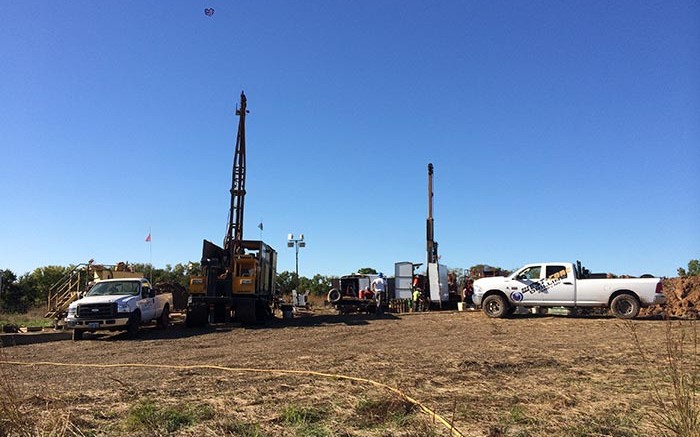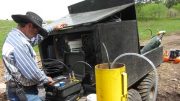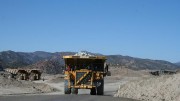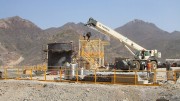The Northern Miner presents its top-10 list of the largest U.S. developers and explorers (with no production).
1. GOLD RESERVE
Market cap: US$237 million

An artisanal miner excavation site at Gold Reserve’s 45%-owned Siembra Minera gold-copper project in Venezuela. Credit: Gold Reserve.
Spokane-based Gold Reserve (TSXV: GRZ; US-OTC: GDRZF) has been collaborating with Venezuelan government-owned Corporacion Venezolana de Mineria S.A. in the development of their Siembra Minera gold-copper project in Venezuela’s Bolivar state, 5 km from Las Claritas, with ownership divided between the company (45%) and the Venezuelan government (55%).
With a preliminary economic assessment of Siembra Minera completed in March 2018, activities started at the project in May 2018, after the local operating company received an environmental permit.
In 2008, Gold Reserve had its licences revoked by the Venezuelan government for its large Brisas gold-copper project in the country, which led to years of legal wrangling and a formal financial settlement in June 2017, which has been partly fulfilled.
2. NIOCORP DEVELOPMENTS
Market cap: US$106 million
From its headquarters in Centennial, Colo., NioCorp Developments (TSX: NB; US-OTC: NIOBF) is developing its wholly owned Elk Creek critical minerals project in southeast Nebraska, which can produce niobium, scandium and titanium. Over a 32-year operating life, the mine could annually produce 7,055 tonnes ferroniobium, 103 tonnes scandium trioxide and 11,445 tonnes titanium dioxide, amounting to a US$17.6-billion projected gross life-of-mine revenue.
3. VISTA GOLD
Market cap: US$61 million

Vista Gold Corp.’s Mt Todd gold project in Australia’s Northern Territory. Photo credit: Vista Gold Corp.
Vista Gold (TSX: VGZ; NYSE-AM: VGZ) is developing its wholly owned Mt. Todd gold project in Australia’s Northern Territory, which the Littleton, Colo.-based junior describes as the “largest undeveloped gold project” in the country, with “world-class scale.”
A 2018 prefeasibility study shows Mt. Todd could produce 490,000 oz. gold annually during the first five years at all-in sustaining costs of US$678 per oz. gold.
Mt. Todd operated as an open-pit, heap-leach operation, but it was closed in 1997 and abandoned in 2001. Vista picked up the property in 2006 and has since invested US$100 million in the project, including 55,000 metres of drilling.
4. PERSHING GOLD
Market cap: US$55 million
Steve Alfers-led Pershing Gold (TSX: PGLC; NASDAQ: PGLC) is working to reopen its Relief Canyon gold mine complex in northwestern Nevada’s Pershing County, some 150 km from Reno. The mine was operated by Pegasus Gold in the 1990s.
A feasibility study completed in May 2018 shows that a reopened heap-leach operation from three pits could produce 91,000 oz. gold per year over a 5.3-year mine life.
The study shows an 87% after-tax internal rate of return and a US$133-million, after-tax net present value.
5. GENERAL MOLY
Market cap: US$53 million
Based in Lakewood, Colo., General Moly (TSX: GMO; NYSE-AM: GMO) is a pure-play molybdenum company with two assets in development, both in Nevada: the 80%-owned Mt. Hope molybdenum project, which the company describes as “one of the world’s largest and highest-grade moly deposits” (Posco owns the rest), and the wholly owned Liberty moly-copper project.
While pre-construction work at Mt. Hope has been suspended, an open-pit mine at the site could produce 20,000 tonnes molybdenum per year within the first five years of production, with an estimated 30-year mine life. Remaining capital expenses at the site are an estimated US$1 billion on a 100% basis.
Liberty is a dormant open-pit mine that could be reopened to annually produce 7,250 tonnes moly and 3,750 tonnes copper during the first five years of production, with a 32-year life.
General Moly’s largest shareholder at 22% is China’s AMER, which has US$49.7 billion in annual revenue.
6. CRYSTAL PEAK MINERALS
Market cap: US$48 million
Formerly named EPM Mining Ventures, Salt Lake City-based Crystal Peak Minerals (TSXV: CPM; US-OTC: CPMMF) is focusing on its Sevier Playa “sulphate of potash” project in southwestern Utah’s Millard County, where proven and probable reserves stand at 6.2 million tonnes.
Crystal Peak completed a feasibility study on the project in January 2018. The junior aims to produce 298,000 tonnes per year over 30 years using brine extraction and recovery via solar evaporation. The after-tax net present value of the project is US$730 million, with a US$412-million estimated capital cost.
7. SCANDIUM INTERNATIONAL MINING
Market cap: US$51 million

Drillers at Scandium International Mining’s Nyngan scandium project in Australia. Credit: Scandium International Mining.
Based in Reno, Nev., Scandium International Mining (TSX: SCY; US-OTC: SCYYF) owns two scandium assets in Australia’s New South Wales state: Nyngan and Honeybugle.
The company aims to turn Nyngan into the “world’s first scandium-only mine” and says its feasibility study of the project in May 2016 “delivered an expanded scandium resource, a first reserve figure and an estimated 33.1% internal rate of return on the project, supported by extensive metallurgical test work and an independent, 10-year global marketing outlook for scandium demand.”
The reserve at Nyngan is 1.43 million tonnes grading 409 grams scandium per tonne, while measured and indicated resources are 16.9 million tonnes at 235 grams scandium per tonne.
A mine at Nyngan could produce 38,000 kilograms of scandium oxide per year.
Honeybugle is an earlier-stage project without a feasibility study.
8. PARAMOUNT GOLD NEVADA
Market Cap: US$26 million

From 2013: Inside the core shack at Paramount Gold and Silver’s Sleeper gold-silver project in Nevada. Photo by Matthew Keevil.
From its head office in Winnemucca, Nev., Paramount Gold Nevada (NYSE-AM: PZG) is developing two gold assets in the Western U.S.: Grassy Mountain in eastern Oregon and Sleeper in northwest Nevada.
Paramount completed a prefeasibility study at Grassy Mountain in July 2018 showing that a US$110-million underground mine operating at 1,300 tons (1,180 tonnes) per day at an irregular schedule and a mill operating at 750 tons (680 tonnes) per day on a 24-7 basis could annually produce 47,000 oz. gold and 50,000 oz. silver, with an initial nine-year mine life.
The Sleeper gold property includes the past-producing Sleeper gold mine operated by Amax Gold from 1986 until 1996, which yielded 1.66 million oz. gold and 2.3 million oz. silver.
9. TRISTAR GOLD
Market cap: US$25 million

R. Mohan Srivastava, vice-president of exploration at TriStar Gold
From its home base in Scottsdale, Ariz., TriStar Gold (TSXV: TSGZF) is developing its Castelo de Sonhos gold project in northern Brazil’s Para state.
The Nick Appleyard-led junior has defined a paleoplacer deposit with resources of 8.9 million measured tonnes grading 1.8 grams gold per tonne for 500,000 contained oz. gold, plus 26.2 million inferred tonnes at 1.2 grams gold for 1 million contained oz. gold.
TriStar recently closed a $2-million equity financing, with proceeds earmarked at Castelo de Sonhos for capital and general corporate purposes.
10. SOLITARIO ZINC
Market cap: US$22 Million

Solitario Zinc’s Florida Canyon zinc project in Peru. Credit: Solitario Zinc.
Denver-based Solitario Zinc (TSX: SLR; US-OTC: XPL) is actively exploring two assets: the Florida Canyon high-grade zinc project in Peru in a joint venture with zinc major Nexa Resources; and the Lik zinc project in Alaska with partner Teck Resources.
Solitario notes that since its purchase of Zazu Metals in 2017, it has grown from a company with just over 361 million lb. attributable zinc-equivalent in the measured and indicated resource category to one with over 2.76 billion lb. attributable zinc-equivalent.






Be the first to comment on "Top 10 US developers and explorers"